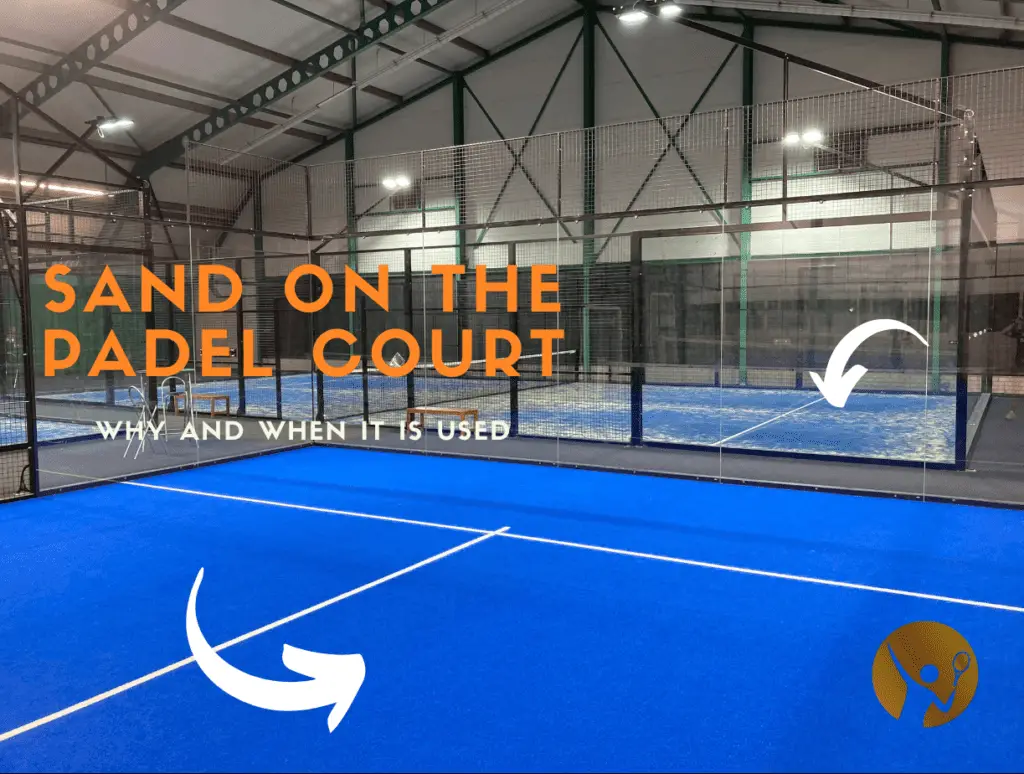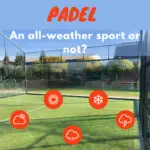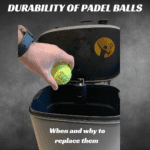This post may contain affiliate links.

While for many people sand is not the first thing that comes to mind when thinking about a padel court, it is definitely of importance. I will cover why and when sand is used for padel courts.
Sand is used to stabilize the padel court and provide consistent playing conditions. While sand is recommended for all courts, the amount of sand is dependent on the type of turf.
Breaking down this high-level answer into multiple aspects, allows me to cover the topic in much more detail. Oh, and if you stick with it, I will provide a recommendation for your court.
Why do padel courts have sand?
Silica sand is used on padel courts to stabilize the turf and ensure consistent playing conditions while reducing the risk of injury.
Stabilize the turf
During a padel match, players move quickly around the court. As a consequence, there is a lot of impact on the court, made of artificial grass (turf). Think about the amount of impact the court needs to endure when you decide to sprint to get the ball ultimately. Regardless of what movement you make, the court needs to remain exactly where it was. As you might have guessed, this is where the sand comes into play. The artificial grass or turf is manufactured in big lanes. In order to ensure these lanes do not wrinkle or fold, they use sand to hold them in place.
Consistent conditions
The ball needs to bounce the same on the court and not behave strangely because the court is not even. The major padel manufacturer Mondo even tests their products with professional padel players to ensure the courts stay in their place and the ball always bounces from the turf as expected.
even tests their products with professional padel players to ensure the courts stay in their place and the ball always bounces from the turf as expected.
How hard would padel be if the ball unreliable bounces? Well, I would even argue that it loses part of the fun factor. That might be the same reason these court manufacturers want sand on the courts, they want to avoid ruining the experience.
Next to providing a consistent experience, there is also the risk that arises for an uneven surface. During the rally, players are so occupied with the game and the ball that they don’t have the mental capacity to watch every step they take. Any misstep as a consequence of the uneven turf can lead to injuries for the players.
Why is silica sand used for padel courts?
Silica sand prevents contamination of the padel court and is able to drain water. Since regular sand contains smaller proportions of silica, it is not suitable to prevent contamination of the court.
While some might think, sand is just sand, who cares? Well, padel court manufacturers do, so let’s find out why exactly they do care. Silica sand (also known as white sand) is different than the sand you might find on the beach for example. Generally, silica sand comes in two different grain sizes, either 0.3 or 0.5 mm.
Silica sand contains two elements, namely oxygen, and silica (known as SiO2 for the scientific minds amongst us). Even though regular sand (brown sand) contains silica, it contains it in smaller proportions. The reason silica sand is used for turf in order to ensure the court is not contaminated by organic organisms. Fun fact: silica is even used in water filtration because of its ability to neutralize the pH balance.
Therefore in order to keep the court as clean as possible (and free from any unwanted fungi fiesta), silica sand is used rather than regular sand. Well nothing wrong with fungi, but not on the court.
Should ALL padel courts have sand?
All padel courts need to have sand on the artificial grass to prevent early deterioration. The amount of sand that is required is dependent on the type of artificial grass used.
Every time players twist and turn on the padel court, there is friction between the artificial grass fibers and the sand. This friction will result in wear and tear of those individual artificial grass fibers and therefore the turf in general. Having sand on all courts might thus feel like a contradictory statement but hear me out…
The optimal quantity and distribution of sand also help to reduce the chance of slipping while twisting and turning in order to return the ball. Too little sand will cause the lower body to remain in the same position while turning… Ouch indeed!
Too much sand on the other hand increases the risk of slipping because there is too little traction of the shoe with the turf. As a consequence, it increases the risk of falling and thus also raises the risk of injury.
If all courts need to have sand, how come it is not visible on some courts?
Padel courts can be using different types of artificial grass mainly depending on the considered usage. Textured artificial grass is better able to keep the sand in its place while remaining stabilized. Since the sand is not moved around the court, there is less sand needed to evenly stabilize the grass. Since there is less sand needed, it is less visible and this is exactly why some people assume no sand is used on some courts. Especially the courts where World Padel Tour matches are played on are the clearest example of courts with hardly any visible grass, at least not from a distance.
The optimum amount of sand for your court
The optimum amount of silica sand ranges between 8-15 kg/m2 depending on the type of artificial grass. For textured artificial grass, the low end of the range is recommended, whereas the high end is best suited for older monofilament and fibrillated grass.
| Type of grass | Quantity per court | Number of sandbags |
|---|---|---|
| Textured | 1600 kg | 64 |
| Monofilament | 3000 kg | 120 |
| Fibrillated | 3000 kg | 120 |
Textured artificial grass requires around 8 kg of sand per squared meter of court, resulting in 1600 kg of sand. Since these silica sandbags come in 25 kg bags, you would need 64 sandbags.
Monofilament and fibrillated artificial grass required around 15 kg of sand per squared meter of court. This results in 3000 kg of sand split over 120 bags.
In order to consistently maintain the level of sand, some manufacturers recommend adding washed and dust-free silica sand on a weekly basis. There is one other factor that impacts the amount of sand you need. Generally, outdoor courts need more sand compared to indoor courts, mainly due to weather conditions. While rain is not so much of a concern in some countries, heavy rainfall can reduce the sand levels of the court.
As eluded to, maintaining the level and distribution of the sand is important. Therefore controlling the level and condition of the sand, as well as redistributing the sand seems a necessary evil. Court manufacturers recommend the inspection of the court by professionals to ensure it is properly maintained and has the right amount of sand.







